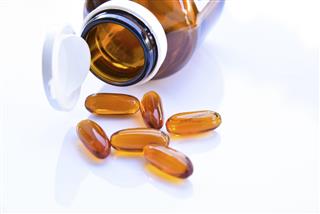
Soy lecithin, present in certain food items, may have side effects. This article elucidates some prominent side effects of the same. Read on. . . .
Soy lecithin is nothing but a phospholipid which is derived from soybeans. It is basically a by-product which is obtained from the processing of soybean. In order to get lecithin, soybeans are tempered and stored at a consistent temperature, and moisture for more than a week. This allows them to hydrate, and helps in the loosening of the hull. The hull is then separated from the beans, and soybean oil is extracted. It is then that soy lecithin is separated from the oil.
This soy product is present in various food products; like, legumes, yeast, egg yolk, soybean, wheat germ, and peanuts to name a few. They are, indeed, certain natural sources of soy lecithin. It is present in food items in a minimal amount; hence, it does not cause side effects. This lipid material consists of two components: choline, and inositol. They help in facilitating the flow of nutrients in, and out of the cell. The side effects of soy lecithin, however, may be observed if, and when taken in excess. People having a weak immune system are prone to the soy milk side effects. Many people take it as a nutritional supplement; thus, before you consume it, acknowledging health discrepancies that soy lecithin may cause, must be known.
Side Effects of Soy Lecithin
Soy lecithin is known to cause adverse effects, if consumed in excess; or worse, without a practitioners’ prescription. Some major discrepant fallouts are as follows:
➢ Soy lecithin can lead to side effects; such as, nausea, abdominal pain, and diarrhea. It is known to cause mild digestive upset, resulting in loose stools. Gastrointestinal problems are caused due to soy lecithin as well.
➢ Some people have experienced excessive weight gain after the consumption of soy lecithin. Contrarily, loss of appetite is a commonly observed side effect.
➢ Skin problems, like, rashes, an itchy skin, and hives are also some reported complaints, if soy lecithin is consumed in excess. These allergies are caused as a result of a weakened immune system. When the system has an access to allergens, or components that are found in soy lecithin, the body reacts by producing antibodies in bulk.
➢ Unpleasant body odor, and bad breath are other side effects of soy lecithin observed. The foul body odor emitted is due to faulty lecithin digestion.
➢ In some people, low blood pressure is observed as a result of excess consumption of soy lecithin. Enduring a syncope, confusion, blurred vision, difficulty in breathing, wheezing, headache, vomiting, and dizziness are some of the commonly observed side effects that occur as a result of low blood pressure.
➢ Soybean is deemed unfit for consumption as it is found to have substances that may promote an uncanny interference with the thyroid hormones. Moreover, a majority of sources of soy are unfermented; ergo, you must choose fermented soy only. Besides the side effect it may cause on one’s thyroid level, it may hamper testosterone levels, and can even be a promoting factor for causing breast cancer.
➢ Other side effects of soy lecithin are coughing, sneezing, runny nose, swelling in the throat, and on the face, difficulty in swallowing, excessive perspiration, anaphylactic shock, and in severe cases, death.
Uses of Soy Lecithin
When soy lecithin is taken in appropriate quantity, it is definitely beneficial. Let’s take a look at some of its uses. It is known to improve heart health and backs the development of the brain. Soy lecithin is known to reduce cholesterol levels in blood. It helps in boosting the immune system, and also aids in detoxifying the system. Due to the above-mentioned benefits, many people use it as a food supplement. Some people use it as an emulsifier for solidifying different food items; like, margarine, and candy bars. It is known to reduce triglyceride.
I hope after knowing the side effects caused due to excess soy lecithin consumption, all of us will make sure that the intake is appropriate.

